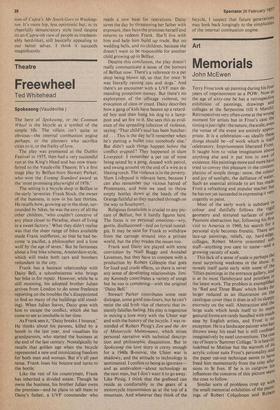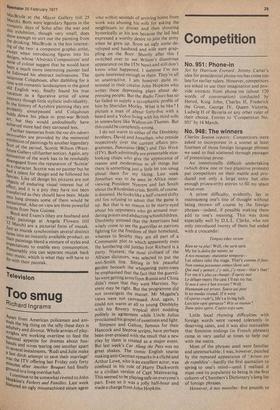Art
Memorials
John McEwen
Terry Frost took up painting during his four years of imprisonment as a POW. Now at the age of sixty-one he has a retrospective exhibition of paintings, drawings and collages at the Serpentine (till 6 March). Retrospectives very often come at the wrong moment for artists but in Frost's case the timing is just right : the nature, the scale, even the venue of the event are entirely aPPr°priate. It is a celebration—as ideally these,. things should be—of work which is its' celebratory. Imprisonment liberated Frost. It taught him to value imagination above anything else and it put him in awe 0f existence. His paintings more and more have tried to convey this pleasure in the conteinplation of simple things: snow, the colour and joy of sunlight, the dalliance of
water.
Such an essential attitude to art has made Frost a refreshing and popular teacher bat he has not yet succeeded in expressing it very cogently in paint. Most of the early work is subdued i.11 colour and dutifully follows the rigid geometry and textured surfaces of Post: Pasmore abstraction but, following his firs' visit to America in 1960, his search for a personal style becomes frenetic. There are lace-up paintings, reliefs, op, hard-edge; collages, Robert Morris orientated scut stuff—anything you care to name—and a growing vacuity of scale. This lack of a sense of scale is perhaps the most surprising weakness in the show. it reveals itself quite early with some of thAe 'fifties paintings in the entrance gallery, an.0 is at its most flamboyant and pointless in the latest work. The problem is exemplified by 'Red and Three Blues' which looks far larger reduced as an illustration on the catalogue cover than it does in all its sloPPY enormity on the wall. Abstraction and the large scale which lends itself to its rnolle gestural forms are rarely handled with mac" ease by English artists, and Frost is 11° exception. He is a landscape painter who ha,s thrown away his easel but is still confine" imaginatively by easel conventions. The one ray of hope is 'Summer Collage.' It is heavily indebted to Matisse but the warmth of its, acrylic colour suits Frost's personality an' the paper cut-out technique seems to have freed him momentarily from the cosy allusions to St Ives. If he is to outgrow his influences the concerns of this picture seer° the ones to follow. Similar sorts of problems crop up With the small memorial exhibition of the paint: ings of Robert Colquhoun and Robert MacBryde at the Mayor Gallery (till 25 March). Both were legendary figures in the romantic days of Soho after the war and this exhibition, though very small, does show enough to sort out the painting from the drinking. MacBryde is the less interesting of the two: a competent graphic artist, except when introducing figures into his designs, whose 'Abstract Composition' and sense of colour suggest that he would have been a much more interesting painter had he followed his abstract inclinations. The saturnine Colquhoun, after dabbling for a time with romantic landscapism in the good old English way, finally found his true 'ocation as a figurative artist of some intensity though little stylistic individuality. In the history of Ayrshire painting they are Probably unsurpassed and Colquhoun holds down his place in post-war British art,. but they would undoubtedly have achieved more had they caroused less. • Further memories from the rue des or/ears Incrayables are provided by the memorial exhibition of paintings by another legendary Scot of the period, Scottie Wilson (Warehouse Gallery till further notice). Again, any estimation of the work has to be resolutely disengaged from the reputation of 'Scottie' as a character. Scottie was no painter but he had a talent for design and he followed his fancies. Like all design his pictures are not objects of enduring visual interest but of effect, and it is a pity they have not been transferred as they should have been. Made into long dresses some of them would be sensational. Also on 'view are three powerful totems from New Guinea. .Boyd and Evans's (they are husband and w,..ife) paintings at Angela Flowers (till March) are a pictorial form of muzak. listas muzak synchronises several distinct tunes into an instantly available product, so their paintings blend a mixture of styles and epxPectations to enable easy consumption. ,resumably you can separate muzak back illto music, which is what they will have to no with their paintak.



































 Previous page
Previous page